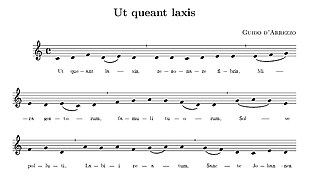Ut queant laxis


"Ut queant laxis"or"Hymnus in Ioannem"is aLatinhymnin honor ofJohn the Baptist,written inHoratianSapphics[1]with text traditionally attributed toPaulus Diaconus,the eighth-centuryLombardhistorian. It is famous for its part in the history ofmusical notation,in particularsolmization.The hymn belongs to the tradition ofGregorian chant.
It is not known who wrote the melody.Guido of Arezzopossibly composed it,[2]but he more likely used an existing melody. A variant of the melody appears in an eleventh-century musical setting of Horace's poemOde to Phyllis(4.11) recorded in a manuscript in France.[3]
Structure
[edit]The hymn uses classicalmetres:theSapphic stanzaconsisting of three Sapphichendecasyllablesfollowed by anadonius(a type ofdimeter).
The chant is useful for teaching singing because of the way it uses successive notes of thescale:the first six musical phrases of eachstanzabegin on a successively higher notes of thehexachord,givingut–re–mi–fa–so–la;thoughutis replaced bydoin modernsolfège.The naming of the notes of thehexachordby the first syllable of eachhemistich(half line of verse) of the first verse is usually attributed toGuido of Arezzo.Guido, who was active in the eleventh century, is regarded as the father of modern musical notation. He made use of clefs (C & F clefs) and invented theut-re-mi-fa-sol-lanotation. The hymn does not help with the seventh tone as the last line,Sancte Iohannes,breaks the ascending pattern. The syllablesi,for the seventh tone, was added in the 18th century.
The first stanza is:
Utqueant laxīs
resonāre fibrīs
Mīra gestōrum
famulī tuōrum,
Solve pollūtī
labiī reātum,
SāncteIohannēs.
It may be translated:So that your servants may, with loosened voices, resound the wonders of your deeds, clean the guilt from our stained lips, O Saint John.
A paraphrase by Cecile Gertken,OSB(1902–2001) preserves the key syllables and loosely evokes the original meter:
Dolet our voices
resonate most purely,
miracles telling,
far greater than many;
so let our tongues be
lavish in your praises,
SaintJohn the Baptist.[4]
Utis now mostly replaced byDoinsolfègedue to the latter'sopensound, in deference to Italian theoristGiovanni Battista Doni.[5]The word "Ut" is still in use to name the C-clef.The seventh note was not part of the medieval hexachord and does not occur in this melody, and it was originally called "si" from "SancteIoannes "(Johannes).[2]In the nineteenth century,Sarah Glover,an English music teacher, renamed "si" to "ti" so that every syllable mightbe notated by its initial letter.But this was not adopted in countries usingfixed-do systems:in Romance languages "si" is used alike for B and B flat, and no separate syllable is required for sharp "sol".
Liturgical use
[edit]In theRoman Rite,the hymn is sung in theDivine Officeon June 24, the Feast of the Nativity ofJohn the Baptist.The full hymn is divided into three parts, with "Ut queant laxis" sung atVespers,"Antra deserti" sung atMatins,"O nimis felix" sung atLauds,anddoxologiesadded after the first two parts.
See also
[edit]- Diatonic and chromatic
- Do-Re-Mi(song). The lyrics teach the solfege syllables by linking them with English homophones (or near-homophones)
- Gamut
- Guidonian hand
- Solmization
References
[edit]- ^Stuart Lyons,Music in the Odes of Horace(2010), Oxford, Aris & Phillips,ISBN978-0-85668-844-7
- ^ab(in French)Ut queant laxisinEncyclopédie Larousse
- ^This manuscript H425 is held inBibliothèque de l'école de Médecine,Montpellier.
- ^Gertken, Cecile:Feasts and Saints,1981
- ^ McNaught, W. G. (1893)."The History and Uses of the Sol-fa Syllables".Proceedings of the Musical Association.19.London: Novello, Ewer and Co.: 43.ISSN0958-8442.Retrieved2010-12-12.

